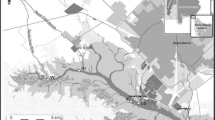Abstract
The marine environment is constantly affected by anthropic actions, with causes consequent degradation of the waters and marine biota by various discharges of xenobiotics. In the present study, the focus was the study of a region of the marine coast of the State of São Paulo (city of Santos), which is one of the most industrialized parts of Brazil and suffers also from a strong impact of domestic effluents. The mussel Perna perna, very abundant in the coast of the State of São Paulo, Brazil, was selected as the biomonitoring organism for the determination of inorganic elements and a passive biomonitoring was performed. The organisms were collected at two sites in São Paulo State coast: Cocanha beach in Caraguatatuba (mussel farm) and Santos Bay (Itaipu and Palmas). Seasonally, the Perna perna were collected between September/08 and July/09 in each study sites. After removal and sample preparation, the elements As, Co, Cr, Fe, Se and Zn were determined by instrumental neutron activation analysis (INAA) and Cd, Pb and Hg were determined by atomic absorption spectroscopy (AAS) in this organism.


Similar content being viewed by others
References
Neves R, Baretta J, Mateus M (2008) Perspectives on integrated coastal management in South America. IST Press, Portugal
Sousa ECPM (1983) Primary production of the benthic microflora living on intertidal flats in the Santos Estuarine System (24oS, 46oW), São Paulo, Brazil. Bolm Inst Oceanogr 32(2):177–186
Lamparelli MC, Costa MP, Prósperi VA, Bevilacqua JE, Araújo RPA, Eysink GGJ, Pompéia S (2001) Sistema Estuarino de Santos e São Vicente. http://www.cetesb.sp.gov.br. Accessed 10 Jan 2011
Abessa DMS (2002) Avaliação da qualidade do sedimento do Sistema Estuarino de Santos, SP, Brasil. PhD. Thesis, Instituto Oceanográfico da Universidade de São Paulo
Pereira CDS (2008) Biomarcadores de exposição, efeito e bioacumulação de xenobióticos em mexilhões Perna perna (Linnaeus, 1758) transplantados ao longo do litoral de São Paulo. PhD. Thesis, Instituto Oceanográfico da Universidade de São Paulo
IMW–International Mussel Watch Committee (1995) International mussel watch project: initial implementation phase, final report. Woods Hole Oceanographic Institution. Coastal Research Center, Woods Hole
National Institute of Standards and Technology, NIST (1998). Certificate of analysis, Standard Reference Material 2976, Mussel Tissue, Gaithersburg
ISO (International Standard Organization) (2005) Statistical methods for use in proficiency testing by interlaboratory comparison-ISO Guide 13528. ISO, Geneva
Moreira EG, Vasconcellos MBA, Saiki M (2006) Uncertainty assessment in instrumental neutron activation analysis of biological materials. J Radioanal Nucl Chem 269:377–382
Moreira EG, Maihara VA, Catharino MGM, Vasconcellos MBA (2005) Report on NIST-CCHEN SIM 8.16P pilot study, elements in seafood
Catharino MGM, Vasconcellos MBA, Sousa ECPM, Moreira EG, Pereira CDS (2008) Biomonitoring of Hg, Cd, Pb and other elements in coastal regions of São Paulo State, Brazil, using the transplanted mussel Perna perna (Linnaeus, 1758). J Radioanal Nucl Chem 278:547–551
CETESB (2009) Relatório da qualidade das águas litorâneas do Estado de São Paulo: Monitoramento das águas - projeto ambiental estratégico Onda Limpa: saneamento básico e qualidade das praias. 2008
Brasil Ministério da Saúde. Secretaria de Vigilância Sanitária, Portaria n° 685, de 27 de agosto de 1998 fixa limites máximos de tolerância de contaminantes químicos em alimentos. Diário Oficial da República Federativa do Brasil, Brasília, 24 de setembro de 1998. Seção 1, parte 1, 1998, p 1415
Brasil Leis, Decretos, etc., Decreto no 55871 de 26 de Março de 1965. Diário Oficial da República Federativa do Brasil, Brasília 09 de abril de 1965, Seção1, parte 1, 1965, p 3611
Acknowledgments
The authors would like to acknowledge the financial support from FAPESP (Research Project 2008/01385-5), from Brazil. The Oceanographic Institute (IO) of the São Paulo University (USP) for the support in the collection of the samples.
Author information
Authors and Affiliations
Corresponding author
Rights and permissions
About this article
Cite this article
Catharino, M.G.M., Vasconcellos, M.B.A., Kirschbaum, A.A. et al. Biomonitoring of coastal regions of São Paulo State, Brazil, using mussels Perna perna . J Radioanal Nucl Chem 291, 113–117 (2012). https://doi.org/10.1007/s10967-011-1291-8
Received:
Published:
Issue Date:
DOI: https://doi.org/10.1007/s10967-011-1291-8




